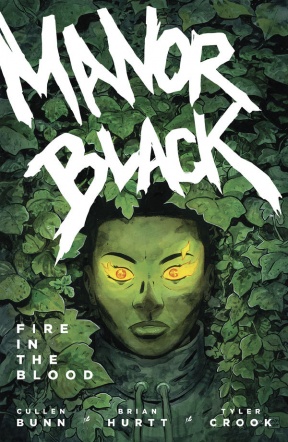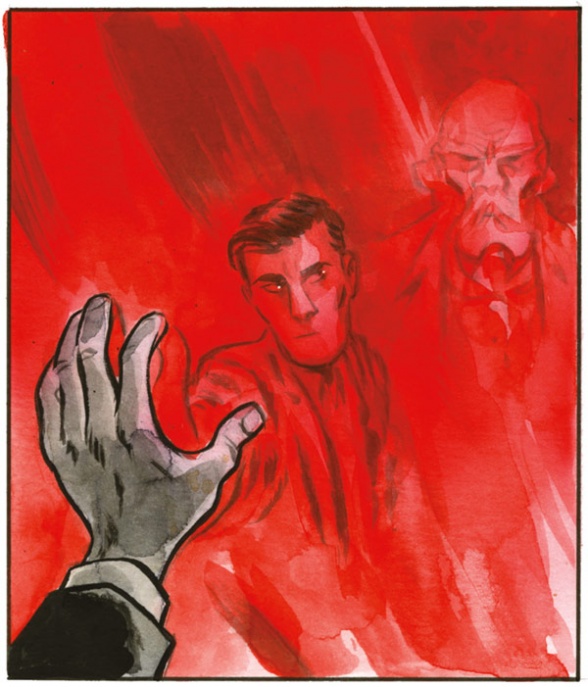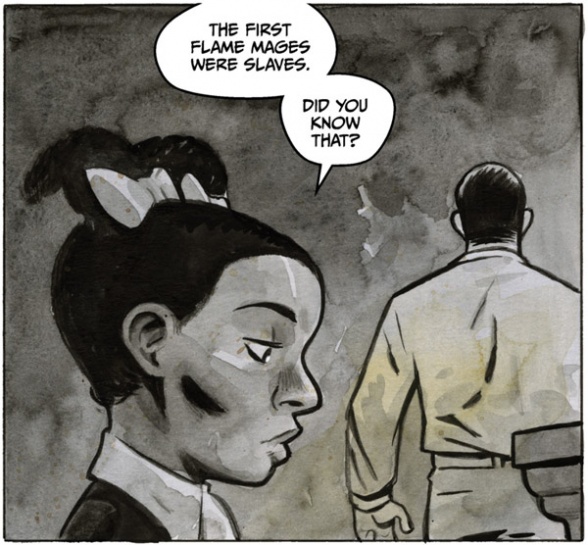One of my favorite comics this year was Cullen Bunn, Brian Hurtt, and Tyler Crook’s “Manor Black: Fire in the Blood.” I previously interviewed the creative team just prior to this arc beginning, but after the series was complete, I wanted to revisit it and dig into the details. This interview is intended for those that’ve already read the issue, so if you haven’t yet, go pick up the trade paperback when it comes out tomorrow, then come back here and read this.

Cullen, you warned us in our last interview, this miniseries definitely has more of a horror story tone. I’m curious what made you choose to do ‘Fire in the Blood’ as a largely flashback tale?
Cullen Bunn: In a lot of ways, the story of “Manor Black” has been a shifting target. There were many possibilities for this next chapter. As I recall, ‘Fire in the Blood’ might not have been planned as our second outing originally. There are many paths into this world and its history. But, because of delayed publishing schedules and such (thanks, pandemic!) our plans moved around a bit. I knew I wanted to dig into Roman’s past a bit, though. I wanted readers to have a better feel for why he turned out the way he did. And that story wasn’t necessarily a happy one. It had been living in my head for a bit when the time came to start work on the book, and I just needed to get it out. Maybe I was in a dark place creatively when I started writing this one.
Yes, ‘Fire in the Blood’ is certainly darker than its predecessor. What surprised me was where that darkness came from. At first, it appeared Maximillian Black’s mind had been corrupted by an outside influence, so even as he was killing his own children, it still read like an attack on the family from the outside. But afterward, when Maximillian has died and his spirit talks to Roman, he expresses no remorse whatsoever—that was truly chilling. And I can’t imagine what it must’ve been like for Roman, having to live with Maximillian hanging around. His sisters are gone and their murderer is bound to the House of Blood’s totem. You did not hold back.

Cullen: I’m glad that came across! Yeah, Roman is dealing with some very heavy, very grim problems. The real question is how all of these issues will impact him going forward.
I found ‘Fire in the Blood’ changed my experience of the first arc, especially when Roman says things we know were also said by his father. It retroactively made the first arc darker and even more interesting to return to. I suspect there’s other things layered into that first arc that will take on new dynamics when further arcs come along.

Right: “Manor Black: Fire in the Blood”
Cullen: That’s the kind of thing I love to do in stories like this, make little connections and callbacks that may alter how you perceive what has come before. To some degree, it frustrates me a bit with books released in a limited series format. I know it can be a necessity for publishers, but I worry that important callbacks like this might get lost during the downtime between arcs.
I wanted to call attention to the timeline for a moment, because there’s some interesting stuff going on here. We know in the present day that Roman is nearly two hundred, so in these flashbacks when he’s returning from World War II, despite his relative youth, he’s probably around a hundred and twenty years old. Hell, he was probably in his forties during the American Civil War, which immediately raises a lot of questions about the relationship between the family and their Black servants. While ‘Fire in the Blood’ introduces a lot, it very much feels like the tip of the iceberg.
Continued belowCullen: There is so much there that has been left unsaid thus far. Some of the dialogue in ‘Fire in the Blood’ starts to hint at this iceberg—an iceberg that has followed Roman Black to the modern era. I think these elements of the past haunt him when he looks at Ari, too. And yet. . . I bet the true history is not something anyone is expecting. It’s the kind of thing we want to get into slowly, over time. I planned to do more of these flashback stories over the course of the series. For a family with magic in their blood, there are many stories to tell over many eras.
Which, of course, brings me to Deidre Cousins. Every single moment with her has me asking more questions—let alone that final scene! She’s such a fascinating addition to the cast.

Cullen: Deidre was actually one of the first secondary characters I came up with for the series. I just couldn’t fit her into the first four issues! That final scene of ‘Fire in the Blood’ is actually a variation of one of the earliest scenes I wrote for the book!
That makes a lot of sense. She feels like she’s embedded in the foundations of the book.
I wanted to quickly touch on the present day material too. The scenes with Ari and Reginald are clearly in conversation with flashback stuff. We also spent a bit of time with Lorelei Black. Her scenes were intriguing to me because they weren’t about capital P plot; they seemed to be more about Lorelei herself, fleshing out her character. If I may say, she’s someone that exudes a quality that makes her seem like she’s older than her youthful appearance would have us believe. At the very least, she’s seen some things.

Cullen: Oh, she has absolutely “seen some things” that have major ramifications on the world of “Manor Black.” I’m glad that came across. It was important to me, though, that we spend even a little time with her as a character. Because she has stepped away from family politics to some degree, we didn’t get to spend as much time with her in the first series. She’s got such a big role to play in “Manor Black” as a whole, so we needed to establish her as a character readers will care about.
Tyler, I’m very curious about the art in this miniseries, because even though I know it’s two artists at work, it really feels like one. You and Brian really blur that line.
Tyler: I am very happy with how the art turned out for this story arc. I have said this before but I’d never colored another person’s artwork like this before. And it was pretty scary when I first started.
So how do you even begin to plan something like this? I mean, this isn’t like taking inked line art and coloring it on a computer. Does Brian talk to you about his plan for a page before he starts inking? Because there’s so much on the page that isn’t defined by inked lines.

Tyler: In this case, the first time I saw the pages were when FedEx dropped them off. On the first issue I did sort of a “color map” to plan out how each scene would get broken down by color. But Brian really encouraged me to just do my thing. I did encourage him to do ink washes because it really helped to establish how he wanted the lighting in the scene to work. Panels like this one are about 80% Brian’s ink washes and 20% my watercolor work.

Oh, wow. That’s really cool to see. I’ve of course seen Brian do ink washes on some of his covers for “The Damned,” but I didn’t realize he was doing them for his “Manor Black” interiors too. Does that present a challenge for you coloring them, to bring out vibrancy in the shadows?
Tyler: Not really. If anything, it makes coloring a lot easier because Brian’s intent is much more clear. I ended up just trying to re-enforce his lighting choices without totally obliterating his washes.
Continued belowI was really impressed with the color work on ‘Fire in the Blood.’ It had so many elements to juggle, but does so invisibly. There’s the subdued present day material, which has multiple story threads and locations to track, but they can ever become too vibrant because vibrancy is the language of the magical power dynamics. The material in the past is in black and white, so on the surface it seems like it’d be easy to separate, but then the magic creeps in, sometimes very subtly.

And on top of all of that, each scene has its own distinct color shape. Did you ever find these various elements clashing for control? Do you have some guiding principles for the color language of “Manor Black.”
Tyler: The only real “rule” that I set up for this series was that flashbacks would be all black and white except for magical elements which would be in color. For the most part, I think that worked well. At least until the magic gets out of hand and the whole page is basically read and yellow.
I’ve isolated Ari’s scenes from ‘Fire in the Blood’ here, so we can see how there’s an overall shape to her journey across this arc, and a shape to each scene as well.

The colors read so cleanly, even as Ari’s story intersects with Reggie’s and Roman’s storylines in the present, and while echoing aspects of the flashback material. It makes me wonder how much Cullen thinks about colour when he writes, because by taking her story from day to night over the course of the four issues, we feel the darkness settle over Ari. The greens from issue #1 contrast with the greens of #4. And there’s a sense of when Ari enters the darkness of the Blood totem crypt, she takes a bit of that darkness with her when she leaves.
Tyler: Sometimes when I read a script, I have a real clear idea of how the colors are going to work throughout the story. But other times I haven’t made up my mind until that page is sitting on my desk and I have to get it colored that day. With a lot of comics work, you end up having to balance the workload with the deadline. As a result, you end up planning your improvisation. Sometimes things work out well, and sometimes it’s a. . . challenge.
I don’t know if this is design or happy accident, but this moment from issue #1 really hit home how Ari’s clothes are perfectly neutral so they can take on whatever magic’s color is at work in any scene. It also hit home that she’s clothed in the colors of ash, which feels very thematically appropriate.

Tyler: That was a happy accident. Honestly, I can’t remember why I chose those colors for Ari’s outfit. The coolest sounding answer would be that I wanted to reference ash and smoke, so I’m going to go with that!
Before we wrap up, Cullen, did you want to drop any hints at where the next arc might go or are you still toying with a few different ideas?
Cullen: Much like the mages, I have secrets I dare not reveal. In the next arc, though, the Stranger reappears, and he begins to plot an event he calls “the Wild Hunt”. And it never rains without a torrential downpour, so while this is going on, Roman finds himself dealing with the ramifications from the final scenes of ‘Fire in the Blood.’ I have eight arcs of “Manor Black” outlined. There’s always a bit of wiggle room, but those stories are the guideposts that will tell the entirety of the tale.



